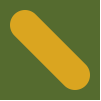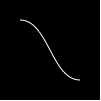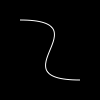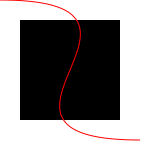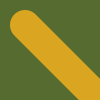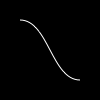2.2 Images: "image.ss"
The image teachpack provides a number of basic image construction functions, along with
combinators for building more complex images out of existing images. Basic images include
various polygons, ellipses and circles, and text, as well as bitmaps (typically bitmaps
come about via the Insert Image... menu item in DrRacket).
Existing images can be rotated, scaled, and overlaid on top of each other.
2.2.1 Basic Images
Constructs a circle with the given radius, height, mode, and color.
If the mode is 'outline or "outline", then the last
argument can be a pen struct or an image-color?, but if the mode
is 'solid or "solid", then the last argument must be an
image-color?.
Examples: |
| > (circle 30 "outline" "red") |
 |
| > (circle 20 "solid" "blue") |
 |
Constructs an ellipsis with the given width, height, mode, and color.
If the mode is 'outline or "outline", then the last
argument can be a pen struct or an image-color?, but if the mode
is 'solid or "solid", then the last argument must be an
image-color?.
Examples: |
| > (ellipse 40 20 "outline" "black") |
 |
| > (ellipse 20 40 "solid" "blue") |
 |
Constructs a upward-pointing equilateral triangle.
The side-length argument
determines the
length of the side of the triangle.
If the mode is 'outline or "outline", then the last
argument can be a pen struct or an image-color?, but if the mode
is 'solid or "solid", then the last argument must be an
image-color?.
Constructs a triangle with a right angle where the two sides adjacent
to the right angle have lengths side-length1 and side-length2.
If the mode is 'outline or "outline", then the last
argument can be a pen struct or an image-color?, but if the mode
is 'solid or "solid", then the last argument must be an
image-color?.
Creates a triangle with two equal-length sides, of length side-length
where the angle between those sides is angle. The third
leg is straight, horizontally. If the angle is less than
180, then the triangle will point up and if the angle
is more, then the triangle will point down.
If the mode is 'outline or "outline", then the last
argument can be a pen struct or an image-color?, but if the mode
is 'solid or "solid", then the last argument must be an
image-color?.
Constructs a square.
If the mode is 'outline or "outline", then the last
argument can be a pen struct or an image-color?, but if the mode
is 'solid or "solid", then the last argument must be an
image-color?.
Examples: |
| > (square 40 "solid" "slateblue") |
 |
| > (square 50 "outline" "darkmagenta") |
 |
Constructs a rectangle with the given width, height, mode, and color.
If the mode is 'outline or "outline", then the last
argument can be a pen struct or an image-color?, but if the mode
is 'solid or "solid", then the last argument must be an
image-color?.
Constructs a four sided polygon with all equal sides and thus where opposite angles are equal to each
other. The top and bottom pair of angles is
angle and the left and right are
(- 180 angle).
If the mode is 'outline or "outline", then the last
argument can be a pen struct or an image-color?, but if the mode
is 'solid or "solid", then the last argument must be an
image-color?.
Examples: |
| > (rhombus 40 45 "solid" "magenta") |
 |
| > (rhombus 80 150 "solid" "mediumpurple") |
 |
Constructs a regular polygon with side-count sides.
If the mode is 'outline or "outline", then the last
argument can be a pen struct or an image-color?, but if the mode
is 'solid or "solid", then the last argument must be an
image-color?.
Constructs a star with five points. The side-length argument
determines the side length of the enclosing pentagon.
If the mode is 'outline or "outline", then the last
argument can be a pen struct or an image-color?, but if the mode
is 'solid or "solid", then the last argument must be an
image-color?.
Example: |
| > (star 40 "solid" "gray") |
 |
Constructs an arbitrary regular star polygon (a generalization of the regular polygons).
The polygon is enclosed by a regular polygon with side-count sides each
side-length long. The polygon is actually constructed by going from vertex to
vertex around the regular polgon, but skipping over every step-count vertices.
For examples, if side-count is 5 and step-count is 2,
then this function produces a shape just like star.
If the mode is 'outline or "outline", then the last
argument can be a pen struct or an image-color?, but if the mode
is 'solid or "solid", then the last argument must be an
image-color?.
Constructs a polygon connecting the given vertices.
If the mode is 'outline or "outline", then the last
argument can be a pen struct or an image-color?, but if the mode
is 'solid or "solid", then the last argument must be an
image-color?.
Constructs an image representing a line segment that connects the points
(0,0) to (x1,y1).
Adds a line to the image
image, starting from the point (
x1,
y1)
and going to the point (
x2,
y2).
Unlike
scene+line, if the line passes outside of
image, the image
gets larger to accomodate the line.
Adds a curve to image, starting at the point
(x1,y1), and ending at the point
(x2,y2).
The angle1 and angle2 arguments specify the
angle that the curve has as it leaves the initial point and
as it reaches the final point, respectively.
The pull1 and pull2 arguments control how
long the curve tries to stay with that angle. Larger numbers
mean that the curve stays with the angle longer.
Unlike scene+curve, if the line passes outside of image, the image
gets larger to accomodate the curve.
Constructs an image that draws the given string, using the font size and color.
Examples: |
| > (text "Hello" 24 "olive") |
 |
| > (text "Goodbye" 36 "indigo") |
 |
Constructs an image that draws the given string, using a complete font specification.
The face and the family combine to give the complete typeface. If
face is available on the system, it is used, but if not then a default typeface
based on the family is chosen. The style controls if the face is italic
or not (under Windows and Mac OS X, 'slant and 'italic are the same),
the weight controls if it is boldface (or light), and underline?
determines if the face is underlined. For more details on these arguments, see font%,
which ultimately is what this code uses to draw the font.
| (bitmap bitmap-spec) |
| |
| bitmap-spec | | = | | rel-string | | | | | | | id |
|
Loads the bitmap specified by bitmap-spec. If bitmap-spec is a string, it is treated as a
relative path. If it is an identifier, it is treated like a require spec and used to refer to a file
in a collection.
Examples: |
| > (bitmap icons/stop-16x16.png) |
 |
| > (bitmap icons/b-run.png) |
 |
2.2.2 Overlaying Images
Overlays all of its arguments building a single image. The first argument goes
on top of the second argument, which goes on top of the third argument, etc.
The images are all lined up on their centers.
Overlays all of its image arguments, much like the
overlay function, but using
x-place and
y-place to determine where the images are lined up. For example, if
x-place and
y-place are both
"middle", then the images are lined up
on their centers.
Examples: |
|
 |
|
 |
Constructs an image by overlaying i1 on top of i2 after
shifting i2 over by x pixels to the right and y
pixels down.
Underlays all of its arguments building a single image.
It behaves like overlay, but with the arguments in the reverse order.
That is, the first argument goes
underneath of the second argument, which goes underneath the third argument, etc.
The images are all lined up on their centers.
Examples: |
|
 |
|
 |
Underlays all of its image arguments, much like the
underlay function, but using
x-place and
y-place to determine where the images are lined up. For example, if
x-place and
y-place are both
"middle", then the images are lined up
on their centers.
Examples: |
|
 |
|
 |
Constructs an image by underlaying i1 underneath of i2 after
shifting i2 over by x pixels to the right and y
pixels down.
This is the same as (overlay/xy i2 (- x) (- y) i1).
Constructs an image by placing all of the argument images in a
horizontal row, aligned along their centers.
Example: |
|
 |
Constructs an image by placing all of the argument images in a horizontal row, lined
up as indicated by the y-place argument. For example, if y-place
is "middle", then the images are placed side by side with their centers
lined up with each other.
Constructs an image by placing all of the argument images in a
vertical row, aligned along their centers.
Example: |
|
 |
Constructs an image by placing all of the argument images in a vertical row, lined
up as indicated by the x-place argument. For example, if x-place
is "middle", then the images are placed above each other with their centers
lined up.
Examples: |
|
 |
|
 |
2.2.3 Placing Images & Scenes
Placing images into scenes is particularly useful when building worlds
and universes using 2htdp/universe.
Creates an empty scene, i.e., a rectangle with a black outline.
Places image onto scene with its center at the coordinates
(x,y) and crops the resulting image so that it has the
same size as scene. The coordinates are relative to the top-left
of scene.
Examples: |
|
 |
|
 |
Adds a line to the image
scene, starting from the point (
x1,
y1)
and going to the point (
x2,
y2); unlike
add-line, this function crops the resulting image to the size of
scene.
Adds a curve to scene, starting at the point
(x1,y1), and ending at the point
(x2,y2).
The angle1 and angle2 arguments specify the
angle that the curve has as it leaves the initial point and
as it reaches the final point, respectively.
The pull1 and pull2 arguments control how
long the curve tries to stay with that angle. Larger numbers
mean that the curve stays with the angle longer.
Unlike add-curve, this function crops the curve, only showing
the parts that fit onto scene.
2.2.4 Rotating, Scaling, Cropping, and Framing Images
Rotates image by angle degrees in a counter-clockwise direction.
Scales image by factor.
The pen sizes are also scaled and thus draw thicker (or thinner)
lines than the original image, unless the pen was size
0. That pen size is treated specially to mean “the
smallest available line” and thus it always draws a one pixel
wide line; this is also the case for 'outline and "outline"
shapes that are drawn with an image-color? instead of
a pen.
Scales image by x-factor horizontally and by
y-factor vertically.
Examples: |
|
 |
| > (ellipse 60 60 "solid" "blue") |
 |
Crops image to the rectangle with the upper left at the point (x,y)
and with width and height.
Returns an image just like image, except
with a black, single pixel frame drawn around the
bounding box of the image.
Generally speaking, this function is useful to
debug image constructions, i.e., to see where
certain sub-images appear within some larger image.
Example: |
|
 |
2.2.5 Image Properties
Returns the width of i.
Returns the height of i.
Returns the distance from the top of the image to its baseline.
Unless the image was constructed with
text or
text/font,
this will be the same as its height.
2.2.6 Image Predicates
This section lists predicates for the basic structures provided by the image library.
Additionally, images inserted into a DrRacket window are treated as
bitmap images, as are instances of image-snip% and bitmap%.
Determines if x is a mode suitable for
constructing images. It can be one of
'solid, "solid", 'outline,
or "outline", indicating if the shape is
filled in or not.
Determines if
x represents a color. Strings, symbols,
and
color structs are allowed as colors.
For example,
"magenta", "black", 'orange, and 'purple
are allowed. Colors are not case-sensitive, so
"Magenta", "Black", 'Orange, and 'Purple
are also allowed, and are the same colors as in the previous sentence.
If a string or symbol color name is not recognized, black is used in its place.
The complete list of colors is available in the documentation for
color-database<%>.
|
| red : (and/c natural-number/c (<=/c 255)) |
| green : (and/c natural-number/c (<=/c 255)) |
| blue : (and/c natural-number/c (<=/c 255)) |
The
color struct defines a color with red, green, and blue components
that range from
0 to
255.
Determines if x is a placement option
for the vertical direction. It can be one
of
"top",
'top,
"bottom",
'bottom,
"middle",
'middle,
"center",
'center,
"baseline", or
'baseline.
The baseline of an image is the place where the bottoms any letters line up, not counting descenders, e.g. the tail on “y” or “g” or “j”.
Determines if x is a placement option
for the horizontal direction. It can be one
of "left",
'left,
"right",
'right,
"middle",
'middle,
"center", or
'center.
Determines if x is an angle, namely
a real number between 0 (inclusive)
and 360 (exclusive).
Determines if x is an integer
greater than or equal to 3.
Determines if x is an integer greater than or equal to 1.
The
pen struct specifies how the drawing library draws lines.
A good default for style is "solid", and
good default values for the cap and join fields
are "round".
Using 0 as a width is special; it means to always draw the
smallest possible, but visible, pen. This means that the pen will always
be one pixel in size, no matter how the image is scaled.
Determines if x is a valid pen style.
It can be one of
"solid", 'solid,
"dot", 'dot,
"long-dash", 'long-dash,
"short-dash", 'short-dash,
"dot-dash", or 'dot-dash.
Determines if x is a valid pen cap.
It can be one of
"round", 'round,
"projecting", 'projecting,
"butt", or 'butt.
Determines if x is a valid pen join.
It can be one of
"round", 'round,
"bevel", 'bevel,
"miter", or 'miter.
2.2.7 Equality Testing of Images
Two images are equal if they draw exactly the same way, at their current size
(not neccessarily at all sizes).
2.2.8 The nitty gritty of pixels, pens, and lines
The image library treats coordinates as if they are in the upper-left corner
of each pixel, and infinitesimally small.
Thus, when drawing a solid square of whose side-length is 10, the image library
colors in all of the pixels enclosed by the square starting at the upper
left corner of (0,0) and going down to the upper left corner of (10,10),
so the pixel whose upper left at (9,9) is colored in, but the pixel
at (10,10) is not. All told, 100 pixels get colored in, just as expected for
a square with a side length of 10.
When drawing lines, however, things get a bit more complex. Specifically,
imagine drawing the outline of that rectangle. Since the border is
between the pixels, there really isn’t a natural pixel to draw to indicate
the border. Accordingly, when drawing an outline square (without a
pen specification, but just a color as the last argument),
the image library uses a pen whose width is 1 pixel, but draws a line
centered at the point (0.5,0.5) that goes down and around to the point (10.5,10.5).
This means that the outline slightly exceeds the bounding box of the shape.
Specifically, the upper and left-hand lines around the square are within
the bounding box, but the lower and right-hand lines are just outside.
The special case of adding 0.5 to each coordinate when drawing the square
applies to all polygon-based shapes, but does not apply when a pen
is passed as the last argument to create the shape.
In that case, not adjustment of the pixels is performed and using a one
pixel wide pen draws the pixels above and below the line, but each with
a color that is half of the intensity of the given color. Using a
pen with with two, colors the pixels above and below the line
with the full intensity.
2.2.9 Exporting Images to Disk
In order to use an image as an input to another program (Photoshop, e.g., or
a web browser), it is necessary to represent it in a format that these programs
can understand. The save-image function provides this functionality,
writing an image to disk using the PNG format. Since this
format represents an image using a set of pixel values, an image written to disk
generally contains less information than the image that was written, and cannot be scaled
or manipulated as cleanly (by any image program).
writes an image to the path specified by filename, using the
PNG format.































